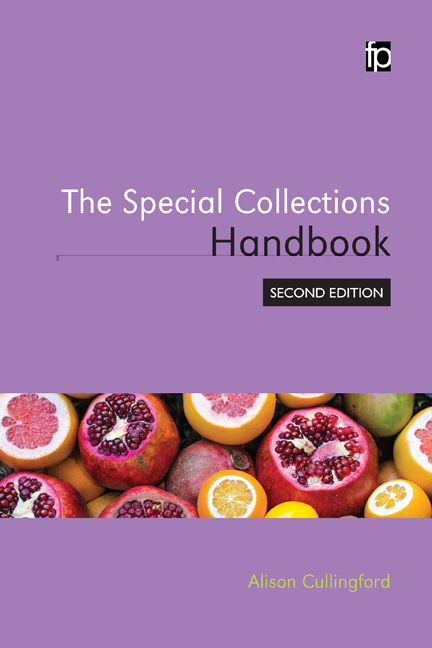Book contents
- Frontmatter
- Contents
- Preface and acknowledgements
- Introduction
- 1 The care of Special Collections
- 2 Emergency planning for Special Collections
- 3 Understanding objects in Special Collections
- 4 Acquiring and developing Special Collections
- 5 Cataloguing, description and metadata in Special Collections
- 6 Digitization and digital libraries in Special Collections
- 7 Legal and ethical issues in Special Collections
- 8 User services in Special Collections
- 9 Marketing and communications in Special Collections
- 10 Widening access to Special Collections
- 11 Organizational resources for Special Collections: space and people
- 12 Influencing and fund-raising for Special Collections
- Afterword: Special Collections futures
- Appendix A The Special Collections reference shelf
- Appendix B Skills for your Special Collections career
- Bibliography
- Index
Introduction
- Frontmatter
- Contents
- Preface and acknowledgements
- Introduction
- 1 The care of Special Collections
- 2 Emergency planning for Special Collections
- 3 Understanding objects in Special Collections
- 4 Acquiring and developing Special Collections
- 5 Cataloguing, description and metadata in Special Collections
- 6 Digitization and digital libraries in Special Collections
- 7 Legal and ethical issues in Special Collections
- 8 User services in Special Collections
- 9 Marketing and communications in Special Collections
- 10 Widening access to Special Collections
- 11 Organizational resources for Special Collections: space and people
- 12 Influencing and fund-raising for Special Collections
- Afterword: Special Collections futures
- Appendix A The Special Collections reference shelf
- Appendix B Skills for your Special Collections career
- Bibliography
- Index
Summary
Introducing Special Collections
So what are Special Collections, and where are they to be found? Special Collections are everywhere!
They are held by all kinds of organizations: research libraries, universities, colleges, schools, national libraries, public libraries, museums, art galleries, archives, historic houses, cathedrals, subscription libraries, learned societies, hospitals, companies, monasteries …
They include many kinds of material: early printed books, manuscripts, pamphlets, ephemera, maps, photographs, archives, newspapers, digital files and much more.
The term ‘Special Collections’ can refer to the collections themselves, the staff who care for them, the physical and virtual spaces they occupy, and the administrative department in a larger library that manages all these entities. In this Handbook, the context should make it clear which meaning is intended.
The term also implies the existence of other, non-special collections. Many Special Collections services are part of a library which offers many other services, an arrangement typical of university and research libraries. However, you will also encounter libraries which contain mostly ‘special’ material, in which case the term is less likely to be used.
Until relatively recently, Special Collections were seen as special because they needed special care: the materials were too old, valuable, rare, unique or fragile to be stored on open library shelves. As we will see in Chapter 1, this remains true: Special Collections materials need particular care if they are to survive, and their well-being should be at the heart of all management activities.
However, Special Collections are special also because of their potential relevance to people outside the library service and in the long term.
This idea becomes explicit in what Peach and Mertens (2014) describe as ‘the more expansive term’ Unique and Distinctive Collections, recently popularized by Research Libraries UK and the Online Computer Library Center (OCLC). This term helps us define and explain the meaning and significance of collections in ways that transcend the traditional discussion of age and financial value (more detail in Cullingford, 2014). In this edition, I continue to use ‘Special Collections’ in most contexts, but refer to ‘unique and distinctive collections’ when appropriate.
- Type
- Chapter
- Information
- The Special Collections Handbook , pp. xiii - xviPublisher: FacetPrint publication year: 2016



